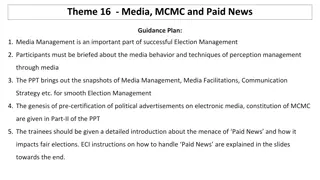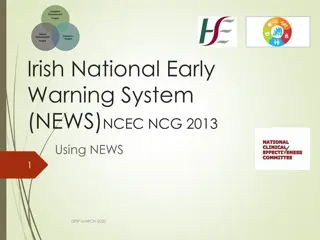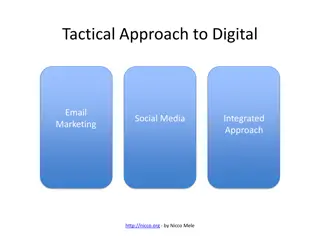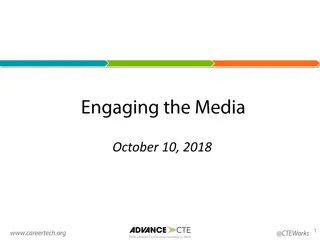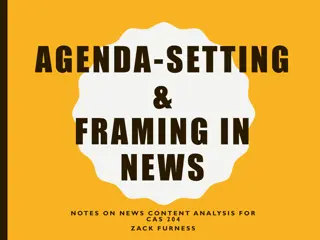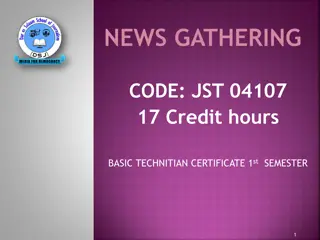News, Media, and Publishing Industries
Explore the world of news and media houses, publishing industries, and data warehouses as taught by Dr. Perpetua S. Dadzie from the Dept. of Information Studies. Learn about the functions and roles of different media platforms and how they impact society. Dive into the topics covered in the sessions and enrich your knowledge on print media, broadcasting, and internet-based media. Delve into the essential concepts of news media, publishing, and data warehousing. Engage with the session materials and reading lists to gain a comprehensive understanding of these industries.
Download Presentation

Please find below an Image/Link to download the presentation.
The content on the website is provided AS IS for your information and personal use only. It may not be sold, licensed, or shared on other websites without obtaining consent from the author.If you encounter any issues during the download, it is possible that the publisher has removed the file from their server.
You are allowed to download the files provided on this website for personal or commercial use, subject to the condition that they are used lawfully. All files are the property of their respective owners.
The content on the website is provided AS IS for your information and personal use only. It may not be sold, licensed, or shared on other websites without obtaining consent from the author.
E N D
Presentation Transcript
Lecturer: Dr. Perpetua S. Dadzie, Dept. of Information Studies Contact Information: psdadzie@ug.edu.gh College of Education School of Continuing and Distance Education 2014/2015 2016/2017
Session Overview At the end of the session, the student will be able to: Describe the role of News and Media Houses Describe the functions of Publishing Houses Understand the role of Data Warehouses Slide 2 Dr. Perpetua Dadzie, Dept of Information Studies
Session Outline The key topics to be covered in the session are as follows: Topic One - News and Media Houses Topic Two Publishing Houses Topic Three Data Warehouses Slide 3 Dr. Perpetua Dadzie, Dept of Information Studies
Reading List News media https://en.wikipedia.org/wiki/News_media Publishing https://en.wikipedia.org/wiki/Publishing Data Warehousing Concepts- http://docs.oracle.com/cd/B10500_01/server.920/a96520/co ncept.htm#49840 Slide 4 Dr. Perpetua Dadzie, Dept of Information Studies
Topic One NEWS AND MEDIA HOUSES Slide 5 Dr. Perpetua Dadzie, Dept of Information Studies
News and Media Houses News is information which is not already known to recipients. News media - major vehicles for the widespread collection and distribution of information. Print media ( newspapers, magazine) Broadcast media (radio stations, tv, tv networks, news agency or wire services Internet based media (WWW, weblogs) Slide 6 Dr. Perpetua Dadzie, Dept of Information Studies
Print Media include all newspapers, newsletters, booklets, pamphlets, magazines, and other printed publications, especially those that sell advertising space as a means of raising revenue. circulation figures of major newspapers around the world has increased over the years; advantages of print media is its capacity to excite and stimulate when people are in a relaxed frame of mind. Another advantage of print is its credibility. If you see it in print, it usually holds a higher position of respect and value Slide 7 Dr. Perpetua Dadzie, Dept of Information Studies
Print Media (2) Examples: Newspaper light and disposable publication, usually printed on low-cost paper (newsprint). May be general or special interest; may be published daily, Weekly, monthly, etc General interest newspapers journals of current news on variety of topics eg. Political, current news, sports, weather, entertainment. May also include weather news and forecasts. Use a lot of photographs to illustrate stories. Slide 8 Dr. Perpetua Dadzie, Dept of Information Studies
Print Media (3) Magazines periodical publication containing variety of articles, generally financed by advertising. Published weekly, biweekly, monthly etc Often printed in colour on coated paper, bound with soft cover. Magazines are subset of periodicals distinct from those produced by scientific, academic or special interest publishers which are subscription-only more expensive, and often having no advertising. Slide 9 Dr. Perpetua Dadzie, Dept of Information Studies
Print Media (4) Careers in Print Media Journalist people who gather news Columnist - a person that gives and adds information to the columns of the newspaper Freelance Journalist - a person who is salaried as per the contribution of the articles he/ she writes Editors - People that design the layout of the matter before the final publishing of the news Sub Editors - A person that adds the final touches to the articles or the news given by the reporters Others: Commentators, Cartoonist, Photojournalist, Reporters and Correspondents etc. Slide 10 Dr. Perpetua Dadzie, Dept of Information Studies
Broadcast Media Broadcasting distribution of audio and video signals to listeners or viewers Traditionally, broadcast media represented by radio and TV. Others are: cable TV, video text Advantage of broadcast media: immediacy, reach large heterogeneous group at same time Disadvantage transient no replay TV 1937 news casters or news anchors Colour in TV Radio intimacy of voice Slide 11 Dr. Perpetua Dadzie, Dept of Information Studies
Broadcast Media (2) Television widely used telecommunication medium for transmitting and receiving moving images, usually accompanied by sound. First regular TV broadcasts began in 1939. Broadcasts can be recorded or live TV has movement, vision and colour In TV, news analyst called news-casters or news anchors. They examine, interpret and broadcast news received from various sources of information Slide 12 Dr. Perpetua Dadzie, Dept of Information Studies
Broadcast Media (3) Radio broadcasting audio sound broadcast through air as radio waves from a transmitter to an antenna and to a receiving device. Stations linked in radio networks to broadcast common programming either in syndication or simulcast or both Audio broadcasting also done via cable, FM, local wire networks, satellite, Internet Slide 13 Dr. Perpetua Dadzie, Dept of Information Studies
Broadcast Media (4) Radio has intimacy of human voice and attractiveness of broadcaster s voice Radio programmes quickly produced, inexpensive and possible to communicate with all ethnic groups in their own language. Slide 14 Dr. Perpetua Dadzie, Dept of Information Studies
Internet Media Internet (Net or Web) is a Network of networks Accessible network of interconnected computer networks that transmit data by packet switching using standard Internet Protocol (IP) Carry various information and services such as email, online chat, file transfer, etc Allow breaking news stories to reach around the globe in seconds Becoming centre of mass media Internet become extremely dominant form of media Slide 15 Dr. Perpetua Dadzie, Dept of Information Studies
Internet Media (2) Blogs website usually maintained by individual with regular entries of commentary, descriptions of events, graphics or video. Many blogs provide commentary or news on a particular subject; personal online diaries; Typical blogs combines text, images, links to other blogs, web pages; other media related to topic Entries commonly displayed in reverse chronological order. Reader able to leave comments in interactive format Slide 16 Dr. Perpetua Dadzie, Dept of Information Studies
Internet Media (3) Blogs . most blogs textual; some focus on art (artlog); photographs (photblog); music (MP3 blog); audio (podcasting) Micro-blogging type of blogging consists of blogs with very short posts Slide 17 Dr. Perpetua Dadzie, Dept of Information Studies
Internet Media (4) News Agency Organization of journalist which supply news reports to organizations in the news trade: newspapers, magazines, radio, TV Also called wire service, newswire or news service. Wire services typically news agencies that provide news to publications, broadcasters and media houses by the minute. They work through technical tie-ups and arrangements with all mainstream news organizations who pay them for the content that they provide Slide 18 Dr. Perpetua Dadzie, Dept of Information Studies
Internet Media (5) News Agency .. The public does not have direct access to this content unless it is featured by local newspaper or TV Examples: Reuters, Ghana News Agency Slide 19 Dr. Perpetua Dadzie, Dept of Information Studies
Video Slide 20 Dr. Perpetua Dadzie, Dept of Information Studies
Activity Visit any media house of your choice and find out how they go about publishing the news Slide 21 Dr. Perpetua Dadzie, Dept of Information Studies
Topic Two PUBLISHING HOUSES Slide 22 Dr. Perpetua Dadzie, Dept of Information Studies
Publishing Houses Publishing process of production and dissemination of literature or information; Activity of making information available for public view Self publishing authors as own publishers originators and developers of content ; also provide media to deliver and display content Traditionally, publishing distribution of printed works such as books and newspapers. With Internet publishing expanded to included electronic resources such as e-books an periodicals, websites, blogs, video games Slide 23 Dr. Perpetua Dadzie, Dept of Information Studies
Publishing Houses (2) Publishing - stages of the development, acquisition, copyediting, graphic design, production , printing, marketing and distribution Process of publishing Writers submit proposal to publisher or literary agent Could be unsolicited submissions; go through slush pile; publishers readers sift through to identify manuscript of sufficient quality Referred to acquisitions editors and then to editorial staff literary agents Acceptance and negotiation intellectual property, royalty Slide 24 Dr. Perpetua Dadzie, Dept of Information Studies
Publishing Houses (3) Acceptance and negotiation Once manuscript accept, commissioning editors negotiate purchase of intellectual property rights; agree on royalty rates Royalties usually range between 10-12% of recommended retail price Editorial, Design, Sales and Marketing Stages Editorial Stage - author may rewrite to improve quality or make changes; Staff edits to ensure house style maintained ; fact checking; style and grammatical checking Slide 25 Dr. Perpetua Dadzie, Dept of Information Studies
Publishing Houses (4) Editorial, Design, Sales and Marketing Stages Design Stage type of book determines amount of design required. For standard fiction titles, design is usually restricted to typography and cover design. For books containing illustrations or images, design takes on a much larger role in laying out how page looks, how chapters begin and end, colours, typography, cover design and ancillary materials such as posters, catalogue images and other sales materials. Slide 26 Dr. Perpetua Dadzie, Dept of Information Studies
Publishing Houses (5) Editorial, Design, Sales and Marketing Stages Design Stage . Non-fiction - most design intensive books, requiring extensive use of images and illustrations, captions, typography and a deep involvement and consideration of reader experience. Slide 27 Dr. Perpetua Dadzie, Dept of Information Studies
Publishing Houses (6) Editorial, Design, Sales and Marketing Stages Sales and Marketing Stage . closely intertwined with editorial process. As front cover images produced or chapters edited, sales people start talking about book with customers to build early interest. Publishing companies produce advanced information sheets sent to customers or overseas publishers to gauge possible sales. early interest measured, information feeds back through editorial process and may affect formatting of book and strategy to sell it. Slide 28 Dr. Perpetua Dadzie, Dept of Information Studies
Publishing Houses (7) Editorial, Design, Sales and Marketing Stages Pre-press When final text agreed upon, next phase is design. May include artwork being commissioned or confirmation of layout. In publishing, word "art" also indicates photographs. Process prepares work for printing through processes such as typesetting, dust jacket composition, specification of paper quality, binding method and casing, and proofreading. Today, activities of typesetting, page layout, production of negatives, plates from negatives and, for hardbacks, preparation of brasses for spine legend and imprint are now all computerized. Slide 29 Dr. Perpetua Dadzie, Dept of Information Studies
Publishing Houses (8) Editorial, Design, Sales and Marketing Stages Printing - Before printing begins, pre-press proof created, sent for final checking and sign-off by publishing company. Proof shows book precisely as it will appear once printed; Final opportunity publisher has to ensure there are no errors in material. Some printing companies use electronic proofs rather than printed proofs. Once proofs have been signed off, printing of book begins. Slide 30 Dr. Perpetua Dadzie, Dept of Information Studies
Publishing Houses (9) Recent Developments New technological changes to publishing industry. Changes include e-books, print on demand and accessible publishing. E-books quickly growing since 2005. Google, Amazon.com and Sony leaders in working with publishers and libraries to digitize books. Ability to quickly and cost effectively Print on Demand means that publishers no longer have to store books at warehouses if the book is in low or unknown demand. Accessible publishing uses digitization of books to mark up books into XML and then produces multiple formats from this to sell to consumers, often targeting those with difficulty reading. Slide 31 Dr. Perpetua Dadzie, Dept of Information Studies
Activity Visit any publishing house of your choice and find out how they go about publishing materials for the market. Slide 32 Dr. Perpetua Dadzie, Dept of Information Studies
Topic Three DATA WAREHOUSES Slide 33 Dr. Perpetua Dadzie, Dept of Information Studies
Data warehouses Data warehouses institutions for managing electronic information Term coined in 1990 by Bill Inmon defined warehouse as subject-oriented, integrated, time-variant and non-volatile collection of data in support of management's decision making process. Subject Oriented means: Data that gives information about particular subject instead of about company's ongoing operations. Integrated: Data that is gathered into data warehouse from variety of sources and merged into coherent whole.
Data warehouses (2) Time-variant: All data in the data warehouse is identified with a particular time period. Non-volatile : Data is stable in a data warehouse. More data is added but data is never removed. This enables management to gain a consistent picture of business. Data mart : a single-subject data warehouse However due to large amounts of storage required, data warehouses today are volatile. Only a certain number of periods of history are kept in warehouse. For instance, if three years of data are decided on and loaded into warehouse, every month the oldest month will be "rolled off" the database, and newest month added.
Data warehouses (3) Preferred definition is : combination of many different databases across an entire enterprise; a central repository for all or significant parts of data that an enterprise's various business systems collect. Typically, data warehouse is housed on an enterprise mainframe server. Benefits of data warehousing common data model for all data of interest regardless of the data's source
Data warehouses (4) Benefits of data warehousing .. Prior to loading data into the data warehouse, inconsistencies are identified and resolved. Simplifies reporting and analysis Information in data warehouse under control of data warehouse users so that, even if source system data is purged over time, information in warehouse can be stored safely for extended periods of time. Because they are separate from operational systems, data warehouses provide retrieval of data without slowing down operational systems.
Data warehouses (5) Benefits of data warehousing . Data warehouses can work in conjunction with and, hence, enhance value of operational business applications, notably customer relationship management (CRM) systems. Data warehouses facilitate decision support system applications such as trend reports (e.g., items borrowed in particular branch library within last two years), exception reports, and reports that show actual performance versus goals.
Data warehouses (6) Disadvantages of data warehouses not the optimal environment for unstructured data. Because data must be extracted, transformed and loaded into warehouse, there is an element of latency in data warehouse data. Over their life, data warehouses can have high costs. The data warehouse is usually not static. Maintenance costs are high. Data warehouses can get outdated relatively quickly. There is a cost of delivering suboptimal information to the organization.
Data warehouses (7) Disadvantages of data warehouses There is often a fine line between data warehouses and operational systems. Duplicate, expensive functionality may be developed. Or, functionality may be developed in the data warehouse that, in retrospect, should have been developed in the operational systems and vice versa.
Video Data warehousing An Overview <iframe width="560" height="315" src="https://www.youtube.com/embed/zTs5zjSXnvs" frameborder="0" allowfullscreen></iframe> Slide 41 Dr. Perpetua Dadzie, Dept of Information Studies
Activity Visit any insurance company, bank, shipping agency to see how data warehouse operates. Slide 42 Dr. Perpetua Dadzie, Dept of Information Studies
References Slide 43 Dr. Perpetua Dadzie, Dept of Information Studies





